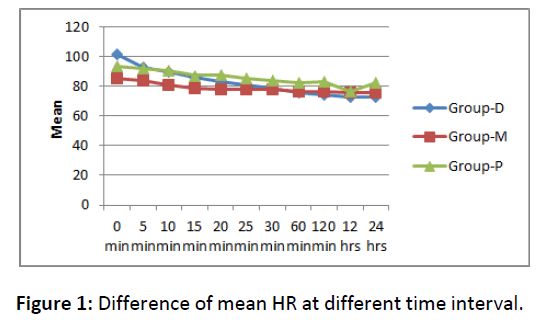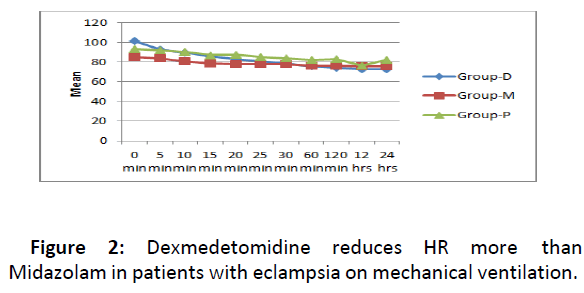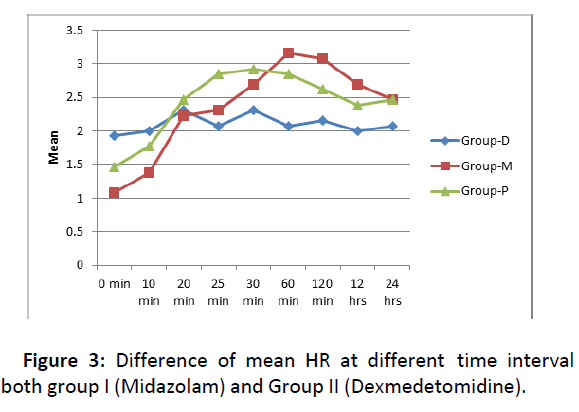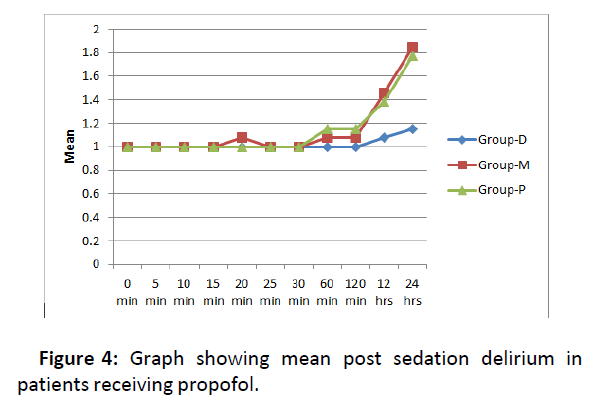Comparison of Dexmedetomidine, Midazolam and Propofol for Sedation of Post-operative Patients on Mechanical Ventilation- A Open Label Randomised Control Trial
Vaskar Majumdar
DOI10.36648/2471-982X.21.7.35
Surajit Paul* and Vaskar Majumdar
Department of Anaesthesiology, Tripura University, Agartala, Tripura, India
- *Corresponding Author:
- Surajit Paul
Department of Anaesthesiology
Tripura University
Agartala, Tripura, India
Tel: 09862993640
E-mail: dr_surajit88@yahoo.com
Received Date: February 25, 2021 Accepted Date: March 11, 2021 Published Date: March 18, 2021
Citation: Paul S, Majumdar V (2021) Comparison of Dexmedetomidine, Midazolam and Propofol for Sedation of Post-Operative Patients on Mechanical Ventilation: An Open Label Randomised Control Trial. Int J Anesth Pain Med Vol.7 No.2:35
Abstract
Mechanical Ventilation is a life-sustaining therapy for the treatment of patients with acute respiratory failure and indeed the advent of its use heralded the dawn of modern intensive care units. Many patients require ventilator support for respiratory insufficiency or abnormal Arterial Blood Gas
Keywords
Mechanical ventilation; Propofol; Haemodynamic; Endotracheal intubation
Introduction
Mechanical ventilation is a life-sustaining therapy for the treatment of patients with acute respiratory failure and indeed the advent of its use heralded the dawn of modern intensive care units. Many patients require ventilator support for respiratory insufficiency or abnormal arterial blood gas. The critically ill surgical patients in the ICU experienced discomfort due to endotracheal intubation and mechanical ventilation, intermittent physiotherapy, tracheal suction etc and also experience pain due to surgical procedure. Moreover noise produced by the monitoring and support system, lighting in the ICU surrounding are not pleasant rather it is enhancing the adverse reactions requiring adequate sedation [1].
Few factors are necessary for better ICU practice like adequate sedation and analgesia which will reduce anxiety and improve the tolerance of the patient on ventilation, reduce fighting against ventilation and also it will increase metabolic and cardiac stability. Practice of ICU sedation has been changed remarkably now a days. Deep sedation is no longer practiced as it increases ICU stay and morbidity on the other hand inadequate sedation result in anxiety, agitation and stressful experiences. An ideal sedative should provide a rapid onset, a rapid recovery, have low profile to accumulate, leaving no withdrawal effects, should be easily titratable and should not disturb hemodynamic stability [2].
Many sedative agents are in use in different ICU setup. Propofol is most commonly used in ICU as sedative agent due to its rapid onset and offset and shot duration of action but few factors which limit the use of propofol are haemodynamic unstability like hypotension and bradycardia and lack of analgesic action [3]. Benzodiazepine mainly Midazolam is another commonly used gamma aminobutyric acid inhibitor having rapid action also frequently used for ICU sedation. Dexmedetomidine is a potent alpha 2 adrenoceptor agonist. Dexmedetomidine is good sedative and also it reduces the need for opioid as it has good analgesic property [4]. This study is conducted to know the safety and efficacy of these three drugs-Dexmedetomidine, Midazolam and Propofol for quality of sedation, haemodynamic stability and requirement of supplemental analgesics in post-operative patients who are in mechanical ventilation in Anaesthesia ICU of AGMC.
Methodology
This is single blinded, open label, randomized control trial conducted in the Anaesthesia Intensive Care Unit (AICU) of Agartala Government Medical College & GBP Hospital from January 2018 to June 2019 on Post-operative patients requiring mechanical ventilator support.
On studying the past records in AGMC for one and half year almost 36 cases may be available. Rounding it to 39 cases which is the study population it is proposed to distribute the patients equally in 1:1:1 ratio in three groups so that each group will receive 13 patients. Since the study population during the study period is less census sampling is planned for recruitment which will have maximum power and type I error <0.05. Allocation concealment is done by sequentially numbered sealed envelope.
Primary variable will be sedation of the patient. Sedation will be assessed by Ramsay Sedation Score. (1=agitated; 2=cooperative, tranquil; 3=responds to verbal command; 4=brisk response to loud voice or glabellar tap; 5=sluggish response to glabellar tap or loud voice; 6=no response)
Secondary variable will be depth of analgesia achieved and hemodynamic stability which will be assessed by Heart Rate, Blood Pressure, Respiratory Rate, and SpO2. The study has been approved by CTRI committee and institutional ethics committee
In this study 39 patients were chosen with GCS 9-15 who are on post-operative mechanical ventilation and they were divided randomly into three groups. Each group has total 13 patients. Group M received Inj. Midazolam loading dose 0.15 mg/kg and then 0.1 mg/kg/hr infusion. Group P received Inj. Propofol 1.5 mg/kg bolus followed by 4 mg/kg/hr continuous infusion and Group D received Inj. Dexmedetomidine bolus dose of 1 micro gm/kg and infusion at the rate of 0.5 micro gm/kg/hr. If any patients need analgesia, Inj. Fentanyl has been used to supplement it. Desired depth of sedation was assessed by Ramsay Sedation Score.
All of them received those study drugs as bolus first at 0 hour and then continuous infusion for atleast 48 hours to keep RSS within 2-3.ventilator mode was set SIMV, Tidal Volume 7-8 ml/kg. HR, SBP, DBP, RR, SpO2 and RSS was assessed at 0.5, 10, 15, 20, 25, 30 min and then at 1 hour and 2 hour. All the patients were closely observed for complications like bradycardia and hypotension and managed accordingly if any. All results are measured in Mean ± SD and ANOVA test has been used for independent variables with normal distribution. SPSS and Excel 2007 has been used for data analysis. P<0.005 has been taken as statistically significant.
Results and Discussion
The difference in mean age and ASA status among the three groups are not statistically significant (p=0.2861 and p=0.4635). There is no statistical significance of sex and GCS status of the patients of these three groups (p=0.4875 and p=0.4672). These findings are similar to study done by [5] where they find no statistical significance Sex, Age and GCS score between their three groups (P>0.05).
In their study in 2018 [6] also found no difference in age and BMI in both groups. In our study we found that difference of mean HR at different time interval was not statistically significant but compared to group M and P, HR falls more in group D and the mean HR is less in Dexmedetomidine group (Figure 1).
No statistical significant difference in SBP and DBP among all these groups.
Findings of our study is also similar to the study conducted by [7] where they studied 40 patients of eclampsia on mechanical ventilation and their study shows that dexmedetomidine reduces HR more than Midazolam in first 24 hour (Figure 2).
Similar results also obtained by [8] by comparing midazolam, propofol and dexmedetomidine in post-operative eclamptic patients on 2017.
In another similar study [6] also found that Mean Arterial Pressure is lower in Propofol group. The HR was lower in Group D patients then Group P and Group M. As per their inference dexmedetomidine is safe and effective sedative agent for mechanically ventilated patients after cardiac surgery. They found that occurrence of bradycardia and hypotension is more in patients who received dexmedetomidine. In our study also one patient of Dexmedetomidine group developed bradycardia after Dexmedetomidine infusion [9].
This finding is similar to the study by [10] where they found that the Ramsay Sedation Score was comparable, and it maintained at a mean score of 2-3 at most time intervals in both group I (Midazolam) and Group II (Dexmedetomidine) (Figure 3).
In a study [11] in 2016 calculated the Asynchrony Index (AI) by tracing electrical activity of diaphragm, airflow etc. and they opined that AI was lower in dexmedetomidine group from 2 hour onwards than propofol group. So they concluded that dexmedetomidine provide better patient ventilator synchrony than propofol. In our study the mean Opioid at 24th hour is more in Midazolam group and it is significantly less in patients receiving dexmedetomidine.
It is also found that morphine required four times more in patients receiving propofol compared to patients receiving dexmedetomidine [12]. We found mean post sedation delirium was not statistically significant (p=0.0798) (Figure 4).
In a similar study [13] concluded that patients receiving dexmedetomidine experience less delirium after extubation. A study conducted on 2017 comparing dexmedetomidine and midazolam and found that patients receiving dexmedetomidine infusion for sedation have quick extubation time and comparatively less duration of ICU stay [14].
Conclusion
In our study we found that difference of mean hemodynamic parameters at different time interval in three drugs was not statistically significant. The Heart Rate of patients at 45 min interval remain lower in Dexmedetomidine Group compared to Midazolam and Propofol Group. There ne incidence of bradycardia in Dexmedetomidine group which was transient and managed accordingly.
The Ramsay Sedation Score was higher in group M and it was steady in group D. Group D patients were easily arousable and they have tolerated ICU procedures like suctioning, physiotherapy etc better compared to other two groups. There is less incidence of post extubation delirium and less requirement of supplementary analgesia in Dexmedetomidine group.
References
- Easton C, Mac KF (1988) Sensory-perceptual alterations: delirium in the intensive care unit. Heart Lung 17: 229-237.
- Coursin DB, Drew CB, Maccioli GA (2001) Dexmedetomidine. Current Opinion in Critical Care 7: 221-226
- Roberts RJ, Barletta JF, Fong JJ, Schumaker G, Kuper PJ, et al. (2009) Incidence of propofol-related infusion syndrome in critically ill adults: a prospective, multicenter study. Critical care 13: 169
- Devlin JW, Lau AK, Tanios MA (2005) Propofol-associated hypertriglyceridemia and pancreatitis in the intensive care unit: an analysis of frequency and risk factors. Pharmacotherapy: The Journal of Human Pharmacology and Drug Therapy 25: 1348-1352
- Jakob SM, Ruokonen E, Grounds RM, Sarapohja T, Garratt C, et al. (2012) Dexmedetomidine vs midazolam or propofol for sedation during prolonged mechanical ventilation: two randomized controlled trials. JAMA 307: 1151-1160
- Elgebaly AS, Sabry M (2018) Sedation effects by dexmedetomidine versus propofol in decreasing duration of mechanical ventilation after open heart surgery. Annals of cardiac anaesthesia 21: 235
- Article 4A of Export Control Order 2008–provisions supplementing "the torture Regulation".
- Rashid MR, Najeeb R, Mushtaq S, Habib R (2017) Comparative evaluation of midazolam, dexmedetomidine, and propofol as Intensive Care Unit sedatives in postoperative electively ventilated eclamptic patients. J Anaesthesiol Clin Pharmacol 33: 331.
- Herr DL, Sum-Ping SJ, England M (2003) ICU sedation after coronary artery bypass graft surgery: dexmedetomidine-based versus propofol-based sedation regimens. J Cardiothorac Vasc Anesth 17: 576-84
- Sharma SK, Ahmad S, Jamir Z, Kumar S, Dwivedi P, et al. (2017) A study of efficacy of dexmedetomidine and midazolam for sedation of eclamptic patients on mechanical ventilation in ICU. J Evolution Med Dent Sci 6: 2415-2418
- Conti G, Ranieri VM, Costa R, Garratt C, Wighton A, et al. (2016) Effects of dexmedetomidine and propofol on patient-ventilator interaction in difficult-to-wean, mechanically ventilated patients: a prospective, open-label, randomised, multicentre study. Critical Care 20: 206.
- Riker RR, Shehabi Y, Bokesch PM, Ceraso D, Wisemandle W, et al. (2009) Dexmedetomidine vs midazolam for sedation of critically ill patients: a randomized trial. JAMA 301: 489-499.
- Dasta JF, Kane-Gill SL, Pencina M, Shehabi Y, Bokesch PM, et al. (2010) A cost-minimization analysis of dexmedetomidine compared with midazolam for long-term sedation in the intensive care unit. Crit Care Med 38: 497-503.
- Tripathi M, Kumar V, Kalashetty MB, Malviya D, Bais PS, et al. (2017) Comparison of dexmedetomidine and midazolam for sedation in mechanically ventilated patients guided by bispectral index and sedation-agitation scale. Anesthesia, essays and researches 11: 288
Open Access Journals
- Aquaculture & Veterinary Science
- Chemistry & Chemical Sciences
- Clinical Sciences
- Engineering
- General Science
- Genetics & Molecular Biology
- Health Care & Nursing
- Immunology & Microbiology
- Materials Science
- Mathematics & Physics
- Medical Sciences
- Neurology & Psychiatry
- Oncology & Cancer Science
- Pharmaceutical Sciences




